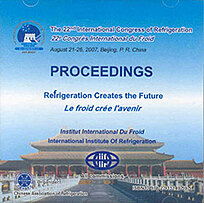
Document IIF
Recherche expérimentale sur un système de conditionnement d'air résidentiel avec accumulation thermique par formation de glace sur serpentin.
Experimental research of cool storage and discharging characteristics on a residential ice-on-coil storage air-conditioning system.
Résumé
Aiming at the users of home, office, and other residential air conditioner users, this thesis puts forward a type of residential ice-on-coil storage air conditioning system. Through experiments, the thesis got the laws of the heat charging characteristics influenced by the initial temperature of the tank and the evaporation temperature of refrigerant, and the heat discharging characteristics influenced by the temperature of the return water and the rate of flow of the cycle water. Furthermore, the temperature distribution of the tank and the changing features of heat charging and discharging characteristics were concluded at different running stages. The results show that the chief influence factor of heat charging processes is the evaporation temperature of refrigerant. The best heat charging performance appeared when the evaporation temperature of refrigeration was set at -10°C. During the heat discharging process, the time of the temperature of chilled water supplied that was lower than 5°C is more than 61% of the whole heat discharging time.
Documents disponibles
Format PDF
Pages : ICR07-E1-862
Disponible
Prix public
20 €
Prix membre*
Gratuit
* meilleur tarif applicable selon le type d'adhésion (voir le détail des avantages des adhésions individuelles et collectives)
Détails
- Titre original : Experimental research of cool storage and discharging characteristics on a residential ice-on-coil storage air-conditioning system.
- Identifiant de la fiche : 2008-0698
- Langues : Anglais
- Source : ICR 2007. Refrigeration Creates the Future. Proceedings of the 22nd IIR International Congress of Refrigeration.
- Date d'édition : 21/08/2007
Liens
Voir d'autres communications du même compte rendu (839)
Voir le compte rendu de la conférence
-
Experimental study on a small residential VRV a...
- Auteurs : WANG J. F., ZHANG H., XIAO H. H.
- Date : 05/04/2008
- Langues : Anglais
- Source : Cryogenics and refrigeration. Proceedings of ICCR'2008.
Voir la fiche
-
An overall assessment of ice storage systems fo...
- Auteurs : TAM A. C., ZIVIANI D., BRAUN J. E., et al.
- Date : 09/07/2018
- Langues : Anglais
- Source : 2018 Purdue Conferences. 5th International High Performance Buildings Conference at Purdue.
- Formats : PDF
Voir la fiche
-
Development of an ice storage integrated into a...
- Auteurs : HEINRICH C., RICHTER M., STELZER F., et al.
- Date : 24/08/2019
- Langues : Anglais
- Source : Proceedings of the 25th IIR International Congress of Refrigeration: Montréal , Canada, August 24-30, 2019.
- Formats : PDF
Voir la fiche
-
Performance evaluation of a CCHP system with th...
- Auteurs : ZHANG X., YANG Q., WU W., et al.
- Date : 06/04/2011
- Langues : Anglais
- Source : Sources/sinks Alternative to the Outside Air for Heat Pump and Air-conditioning Techniques (Alternative Sources - AS), Padua, Italy, April 5-7, 2011. / International Sorption Heat Pump Conference (ISHPC11), Padua, Italy, April 6-8, 2011.
- Formats : PDF
Voir la fiche
-
Water-based thermal energy storage for heating ...
- Auteurs : ALGHAMDI K. I., BACH C. K., SPITLER J. D.
- Date : 2022
- Langues : Anglais
- Source : 2022 Purdue Conferences. 19th International Refrigeration and Air-Conditioning Conference at Purdue.
- Formats : PDF
Voir la fiche
